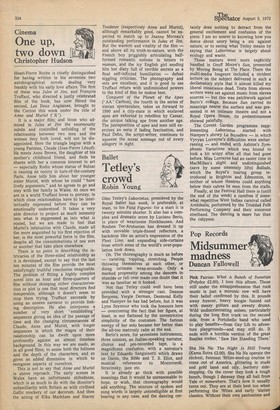Ballet
Tetley's crowd
Robin Young
Glen Tetley's Laborintus, premiered by the Royal Ballet last week, is preferable, at least, to his Field Figures: for a start it is twenty minutes shorter. It also has a complex and dramatic score by Luciano Berio, in place of wearisome Stockhausen. And Rouben Ter-Arutunian has dressed it up with movable triple-finned reflectors, a backdrop like an artist's impression of the Fleet Line, and expanding side-curtains from which some of the world's over-population look down.
Oh. The choreography is much as before twisting, toppling, stretching. People throwing themselves at each other, or doing intimate wrap-arounds. Only it marked propensity among the dancers to stumble or fall over made one doubt that it was as familiar as it looked.
Not that Tetley could well have been provided with a stronger cast. Deanne Bergsma, Vergie Derman, Desmond Kelly and Nureyev he has had before, but it was Lynn Seymour who took the honours here — overcoming the fact that her figure, at least, is not flattered by the unrestrictive simplicity of the costumes. The furious energy of her solo became her better than the all-too matronly calm at the end.
Berio's score, for seventeen instruments, three soloists, an Italian-speaking narrator, chorus and pre-recorded tape, is a magnificent confusion, with a narrator's text by Eduardo Sanguinetti which draws on Dante, the Nile and T. S. Eliot, and musical references to Monteverdi, Stravinsky, jazz etc.
It is already go thick with possible meanings that it would be unreasonable to hope, or wish, that choreography would add anything. The mixture of spoken and sung words is largely unintelligible at first hearing in any case, and the dancing cer tainly does nothing to detract from the general excitement and confusion of the piece. I am no nearer to knowing how you dance about usury being a sin against nature, or to seeing what Tetley means by saying that Laborintus is largely about ecology and waste.
Those matters were more explicitly handled in Geoff Moore's Sun, presented by Moving Being at The Place. There the multi-media longeurs included a strident lecture on the subject delivered in such a declamatory style that it almost killed my liberal conscience dead. Texts from eleven writers were set against music from eleven sources — but this was patchwork against Berio's coldage. Because Sun carried its meanings nearer the surface and was presented in an intimate theatre and not a Royal Opera House, its pretentiousness showed painfully.
The Covent Garden programme supplementing Laborintus started with Nureyev's showy La Bayadere — in which Vyvyan Lorrayne's difficulties were embarrassing — and ended with Ashton's Symphonic Variations which was bound to look a bit wispy after all that had gone before. Miss Lorrayne had an easier time in MacMillan's slight and undistinguished (save by some unseemly lifts) Ballads, which the Royal's touring group introduced in Brighton and Edmonton, in neither of whose theatres could anything below their calves be seen from the stalls.
Finally, at the Festival Hall there is (until the end of the week) a carefree if somewhat repetitive West Indian carnival called Ambikaila, performed by the Trinidad Folk Performing Company and their sonorous steelband. The dancing is more fun than the calypsos.














































 Previous page
Previous page